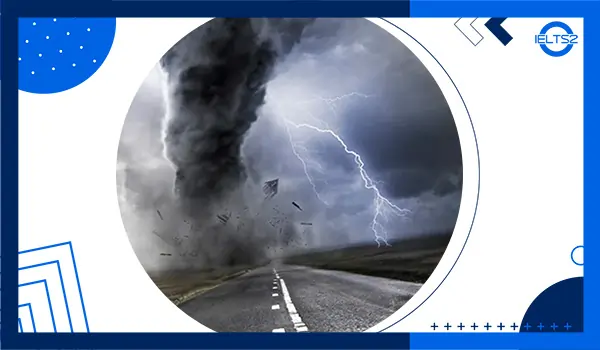نمونه سوالات اسپیکینگ آیلتس درباره بلایای طبیعی (پارت 1 2 3)
در این بخش بیش از 20 مورد از نمونه سوالات اسپیکینگ آیلتس نمره 9 درباره “موضوع بلایای طبیعی” را با هم میبینیم. این مجموعه از آخرین سوالات گزارش شده از سنترهای برگزار کننده آیلتس در ایران و خارج از کشور مربوط به پارت 1، 2 و 3 می باشند و شانس تکرار آن ها در آینده بالاست. در ادامه مطلب همچنین نکات گرامری، لغات و دلایل دریافت نمره 9 را به طور مشخص توضیح داده ایم تا راهنمایی برای علاقمندان باشد. 1000 نمونه سوالات اسپیکینگ آیلتس با جواب PDF پارت 1 2 3 پیشنهاد بعدی ما به شما عزیزان است.
نمونه سوالات اسپیکینگ آیلتس درباره موضوع بلایای طبیعی (پارت 1)
Part 1: Questions and Band 9 Sample Answers
1. Have you ever experienced a natural disaster?
Not personally, but a few years ago, a strong storm hit my city. There was heavy rain, strong winds, and power outages for several hours. While it wasn’t life-threatening, it made me realize how unpredictable nature can be. I remember seeing fallen trees and flooded streets. The experience made me appreciate how important it is to be prepared and aware of weather alerts. It also sparked my interest in environmental issues and emergency preparedness.
2. What natural disasters are common in your country?
In my country, earthquakes and floods are the most common natural disasters. Earthquakes, in particular, are frequent due to our location on a major fault line. Flooding often happens during the rainy season, especially in low-lying areas. These disasters have a significant impact on infrastructure, agriculture, and people’s lives. The government has implemented several measures to mitigate their effects, such as early warning systems and emergency response teams. Still, public awareness and preparedness are key.
3. Do you think climate change has influenced the frequency of natural disasters?
Absolutely. Climate change has intensified many natural disasters, making them more frequent and severe. For example, rising global temperatures have led to stronger storms, longer droughts, and more devastating wildfires. Scientific reports show clear correlations between climate change and extreme weather patterns. I believe it’s crucial for governments and individuals to address this issue seriously by reducing carbon emissions and promoting sustainable practices. If we don’t act now, future generations will face even greater challenges.
4. How can people prepare for natural disasters?
People can prepare by staying informed, creating emergency kits, and having a clear evacuation plan. Schools and workplaces should regularly conduct drills to ensure everyone knows what to do in case of a disaster. Governments should also invest in resilient infrastructure and public education campaigns. On a personal level, keeping important documents safe, stocking food and water, and knowing local emergency contacts can make a huge difference. Preparation can save lives and reduce panic during crises.
5. Are natural disasters taught about in schools in your country?
Yes, schools in my country include natural disaster education as part of the curriculum. Students learn about different types of disasters, their causes, and safety procedures. They also participate in regular drills, such as earthquake simulations. This education fosters awareness from a young age and helps students feel more confident and less anxious during real emergencies. I think it’s a valuable part of education because it equips children with knowledge that could one day save their lives.
6. What role do the media play in covering natural disasters?
The media play a crucial role in raising awareness and delivering timely information during natural disasters. News outlets provide updates on affected areas, safety tips, and government announcements. Social media platforms also allow people to share real-time information and locate missing persons. However, the media must ensure accuracy to prevent misinformation and panic. Overall, media coverage helps coordinate aid efforts and keeps the public informed, which is essential during emergency situations.
7. Can technology help predict natural disasters?
Definitely. Advances in technology have greatly improved our ability to predict natural disasters. Seismographs can detect early signs of earthquakes, and satellites help monitor hurricanes, floods, and wildfires. These tools enable scientists to issue warnings that can save lives. Additionally, apps and alert systems notify people instantly about potential dangers. Although we can’t prevent natural disasters, technology helps us reduce their impact through early detection and efficient communication.
8. How can the damage from natural disasters be reduced?
Damage can be reduced through proper urban planning, strong infrastructure, and public education. Building codes should require structures to withstand earthquakes and floods. Governments must invest in drainage systems and early warning mechanisms. Community preparedness programs are also essential. On an individual level, people should know evacuation routes and keep emergency supplies ready. When all these measures are in place, societies become more resilient and better equipped to handle disasters.
9. Do you think international cooperation is important in dealing with natural disasters?
Yes, international cooperation is vital. Natural disasters often surpass national capacities, so countries need to collaborate. Sharing resources, expertise, and technology can enhance response efforts. For instance, international aid can provide immediate relief to affected areas, while joint research can improve forecasting models. Climate change, a key driver of many disasters, also requires a united global approach. I believe that through international partnerships, we can build a more resilient and prepared world.
10. What is the economic impact of natural disasters?
Natural disasters can have devastating economic consequences. They destroy infrastructure, halt businesses, and displace workers, leading to significant financial losses. Recovery costs are often enormous, affecting government budgets and long-term development plans. For example, rebuilding after a major earthquake can take years and billions of dollars. Insurance premiums rise, and investors may lose confidence. The poorest communities usually suffer the most, making economic recovery a slow and challenging process.
نمونه سوالات اسپیکینگ آیلتس درباره موضوع بلایای طبیعی (پارت 2)
Part 2: Long-Turn Question and Band 9 Sample Answer
Describe a natural disaster you have heard about.
You should say:
What it was and where it happened
When it occurred
How you learned about it
And explain how people responded to it
Sample Answer:
One natural disaster that deeply impacted me was the massive earthquake that struck Nepal in April 2015. The earthquake measured 7.8 on the Richter scale and caused widespread destruction in Kathmandu and surrounding areas. Thousands of buildings collapsed, including historic monuments, homes, and schools, and over 9,000 people lost their lives.
I first learned about it on the news while watching TV with my family. The footage showed people trapped under rubble, hospitals overwhelmed with injured victims, and rescue teams digging through debris with their bare hands. It was heartbreaking to watch, especially seeing children who had lost their families. Social media was also filled with posts about people searching for their loved ones and appealing for help.
The global response to this disaster was remarkable. Countries from around the world sent rescue teams, medical supplies, and financial aid to support relief efforts. The United Nations coordinated with the Nepalese government to ensure that affected people received food, shelter, and medical care. Non-profit organizations played a crucial role by mobilizing volunteers and raising funds quickly.
Locally, the Nepalese people showed incredible resilience. Despite losing their homes and loved ones, many volunteered to help others. Strangers came together to form human chains to remove debris, and schools turned into makeshift shelters. The disaster not only brought out the worst in terms of destruction but also the best in human kindness and solidarity.
This event taught me a lot about the unpredictability of life and the importance of being prepared for emergencies. It also reminded me of the power of community and international cooperation in the face of tragedy.

نمونه سوالات اسپیکینگ آیلتس درباره موضوع بلایای طبیعی (پارت 3)
Part 3: Discussion Questions and Band 9 Sample Answers
1. Why do some regions experience more natural disasters than others?
Geographical location plays a major role. Areas along tectonic plate boundaries are more prone to earthquakes and volcanic eruptions, while coastal regions are vulnerable to hurricanes and tsunamis. Climate also contributes; for example, tropical regions are more susceptible to floods and cyclones. Human factors such as deforestation and urban sprawl can exacerbate the impact of natural disasters. Regions with weak infrastructure and limited resources are also more affected. Thus, both natural and man-made elements determine the frequency and severity of disasters.
2. What responsibilities do governments have during a natural disaster?
Governments are responsible for protecting citizens before, during, and after disasters. This includes investing in early warning systems, ensuring emergency services are well-equipped, and providing accurate information. During a crisis, authorities must coordinate rescue operations, deliver aid, and maintain public order. Afterward, they should support rebuilding efforts and help affected communities recover. Transparency and timely response are critical. Governments should also collaborate with NGOs and international agencies to enhance their capabilities and ensure efficient disaster management.
3. How can education reduce the impact of natural disasters?
Education promotes awareness and prepares individuals to act appropriately during emergencies. Schools can teach children about disaster types, safety procedures, and first aid. Communities can organize workshops and drills to reinforce knowledge and practice evacuation plans. Informed citizens are less likely to panic and more likely to help others. Education also fosters a culture of preparedness, encouraging people to build safer homes and follow official guidelines. Over time, a well-educated population becomes a resilient one.
4. Should building regulations be stricter in disaster-prone areas?
Absolutely. In areas prone to earthquakes, floods, or hurricanes, strict building codes are essential. These regulations ensure that structures are designed to withstand specific types of disasters, minimizing casualties and damage. While they may increase construction costs, the long-term savings in lives and repairs are worth it. Moreover, governments can provide incentives or subsidies to help people comply. Ultimately, stricter regulations are a proactive step toward reducing future risks and creating safer communities.
5. Why is international aid important after a natural disaster?
Natural disasters often overwhelm a country’s resources, making international aid crucial. Foreign assistance provides financial support, medical supplies, food, and skilled personnel. International NGOs can mobilize quickly and reach affected areas efficiently. Aid also helps rebuild infrastructure and revive local economies. Furthermore, global cooperation demonstrates solidarity and strengthens diplomatic ties. Without international aid, many developing countries would struggle to recover, prolonging suffering and instability. Therefore, timely and coordinated global support is essential.
6. How does the media influence public perception during natural disasters?
Media shapes how people perceive disasters by highlighting specific aspects, such as devastation or heroic rescues. Positive coverage can inspire donations and volunteerism, while sensationalism may cause panic or spread misinformation. Social media enables real-time updates, but it’s also prone to rumors. Responsible journalism is crucial; it ensures accurate reporting and educates the public on how to respond. Overall, the media’s influence can be both helpful and harmful, depending on the integrity of the information shared.
7. Do you think wealthy countries have a greater responsibility in disaster relief efforts?
Yes, wealthier nations often have more resources and advanced technology, placing them in a stronger position to assist. They can provide funds, logistics, expertise, and manpower swiftly. Additionally, many developed countries have contributed significantly to climate change, which increases the frequency of disasters. Hence, they have a moral obligation to support less developed nations. Active participation in disaster relief not only aids those in need but also fosters global cooperation and humanitarian values.
8. How do natural disasters affect mental health?
Survivors of natural disasters often experience trauma, anxiety, depression, and PTSD. The sudden loss of loved ones, homes, or livelihoods can be emotionally overwhelming. Many suffer from survivor’s guilt or ongoing fear of another disaster. Access to mental health support is crucial during recovery. Community-based counseling, peer support groups, and professional therapy can help individuals cope and heal. Mental well-being should be prioritized alongside physical recovery in disaster response plans.
9. What role do non-governmental organizations (NGOs) play in disaster management?
NGOs are essential in providing immediate relief and long-term recovery assistance. They often mobilize faster than governmental agencies and can operate flexibly on the ground. NGOs distribute food, water, and medical aid, offer shelter, and support rebuilding efforts. They also conduct risk assessments and training programs to improve community resilience. Moreover, NGOs raise awareness and advocate for policy changes. Their close ties with local communities enhance the effectiveness and sustainability of their efforts.
10. In what ways can communities build resilience against natural disasters?
Resilient communities prioritize preparedness and collaboration. They invest in disaster-resistant infrastructure, educate residents, and create emergency response teams. Local leaders can coordinate drills, maintain supply centers, and establish communication networks. Social cohesion is also important—neighbors supporting one another can save lives. Additionally, communities can advocate for government support and participate in decision-making. A proactive and united community is better equipped to minimize damage, recover quickly, and adapt to future challenges.
تحلیل گرامر و واژگان پاسخها و دلیل نمره 9 در پاسخ اسپیکینگ آیلتس بالا
در پاسخهای اسپیکینگ آیلتس بالا، چندین عامل باعث شدهاند که نمونهها به سطح نمره ۹ در اسپیکینگ آیلتس برسند:
1. دامنه لغات وسیع و دقیق
: استفاده از واژگان تخصصی مانند “infrastructure,” “resilience,” “recovery efforts,” “climate change,” و “community cohesion” نشاندهنده دایره واژگان پیشرفته است.
2. گرامر پیچیده و صحیح:
در اسپیکینگ آیلتس با موضوع بلایای طبیعی جملات ترکیبی، مجهول، شرطی نوع دوم و سوم، و زمانهای مختلف گرامری بهدرستی و متنوع استفاده شدهاند.
3. روانی (Fluency) و انسجام (Coherence):
پاسخها بهصورت روان ارائه شدهاند و ایدهها بهخوبی به هم متصل شدهاند؛ استفاده از واژگان ربط مانند “therefore,” “furthermore,” “while,” و “despite”.
4. تلفظ و آهنگ گفتار (در نسخه صوتی):
اگر پاسخها بهصورت شفاهی ارائه شوند، الگوی تلفظ، تأکید کلمات، و لحن طبیعی نیز تأثیرگذار خواهد بود.
5. پوشش کامل سوال:
هر سوال بهطور دقیق و کامل پاسخ داده شده است، همراه با مثالهای واقعی و تحلیل موضوع.
6. استفاده از مثالهای واقعی و تحلیل شخصی:
بهجای پاسخهای کلیشهای در اسپیکینگ آیلتس با موضوع بلایای طبیعی، از مثالهایی مثل زلزله نپال استفاده شده که اعتبار پاسخ را بالا میبرد.
این عوامل، ترکیبی از مهارتهای زبانی، آگاهی موضوعی، و توانایی در برقراری ارتباط مؤثر هستند که باعث دریافت نمره کامل در بخش اسپیکینگ آیلتس میشوند.
مطالبی برای مطالعه بیشتر
رایتینگ درباره موضوع طبیعت (IELTS Discussion Essay)
آهنگ New York Mining Disaster از Bee Gees (با ترجمه فارسی)
لغات آیلتس موضوع سوانح (Accidents)
سوالات اسپیکینگ آیلتس درباره ارتش (پاسخ نمره 9)
تعیین سطح رایگان اسپیکینگ ❤️
نمونه سوالات اسپیکینگ آیلتس درباره “موضوع بلایای طبیعی” پارت 1 2 3 را به همراه سمپل های نمره 9 آن ها با هم دیدیم. در ادامه نمونه سوالات دسته بندی شده اسپیکینگ آیلتس پیشنهاد آخر ما به دوستان گرامی هست. این نمونه سوالات اسپکینگ از پرتکرار ترین تاپیک های این بخش و همچنین جدیدترین موضوعات می باشند. این مجموعه توسط یکی از سایت های معتبر و فعال آیلتس تنظیم شده است. همچنین برای تعیین سطح و تعیین رایگان نمره اسپیکینگ و دریافت جدید ترین سمپل های نمره 9 در کانال تلگرام اسپیکینگ ما همراه باشید و به ادمین برای تعیین نمره اطلاع دهید.






